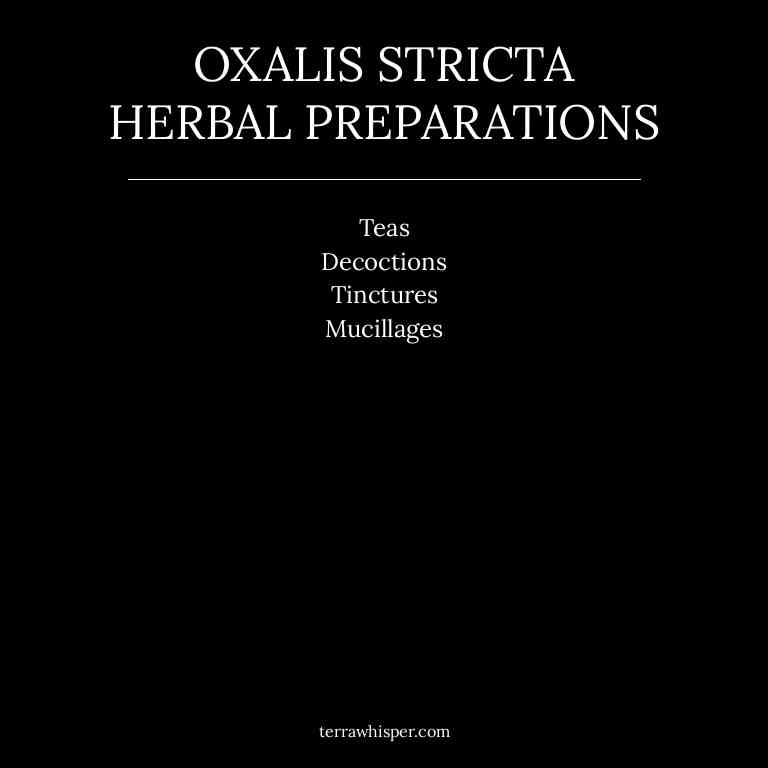Oxalis Stricta Uses, Benefits, And Remedies

Oxalis stricta, commonly known as wood sorrel, is a flowering plant belonging to the Oxalidaceae family, characterized by its heart-shaped leaves and clusters of small yellow flowers.
This herb is valued for its potential health benefits, including its ability to support digestive health, reduce inflammation, and act as a natural diuretic.
The therapeutic actions of Oxalis stricta are attributed to its bioactive constituents such as oxalic acid, flavonoids, and tannins, which contribute to its antioxidant and antimicrobial properties.
Herbal preparations such as infusions, tinctures, and poultices can be made from the leaves and flowers to harness its medicinal properties.
This page analize the most important medicinal aspects of Oxalis stricta.
- Health Benefits
- Bioactive Constituents
- Medicinal Parts
- Herbal Preparations
- Side Effects of oxalis stricta
Health Benefits
Oxalis stricta antioxidant properties are due to its high concentration of phenolic compounds and flavonoids, which neutralize free radicals and reduce oxidative stress in the body.
Its antibacterial properties come from the presence of bioactive compounds in its leaves that inhibit the growth of harmful bacteria such as *Staphylococcus aureus* and *Escherichia coli*. It boosts the immune system by stimulating the production of white blood cells and enhancing the body’s ability to fight off infections and diseases. Its anti-inflammatory effects are attributed to the presence of compounds that suppress pro-inflammatory cytokines and reduce inflammation in tissues.
It has antifungal properties because the leaves contain natural compounds that inhibit the growth of fungi like *Candida albicans* and *Aspergillus niger*.
The 10 best health benefits of Oxalis stricta are shown in the image below.

The list below give a brief description of the 10 best health benefits of Oxalis stricta.
- Antioxidant Properties: Oxalis stricta contains compounds that help neutralize free radicals, reducing oxidative stress and supporting overall cellular health.
- Antibacterial Its Leaves: The leaves of Oxalis stricta possess antibacterial properties that can help combat harmful bacteria and prevent infections.
- Boost Immune: Regular consumption of Oxalis stricta may enhance immune function by stimulating the body's natural defenses against pathogens.
- Anti-Inflammatory: This herb has anti-inflammatory effects that can help reduce inflammation in the body, potentially alleviating symptoms of inflammatory conditions.
- Antifungal Its Leaves: The leaves of Oxalis stricta exhibit antifungal properties, making them useful in treating fungal infections and preventing their spread.
- Reduce Fever: Oxalis stricta is traditionally used to lower body temperature and may help in reducing fever naturally.
- Heal Wounds: The herb is known to promote wound healing by accelerating tissue repair and reducing the risk of infection in the affected area.
Bioactive Constituents
Oxalis stricta carbohydrates play a significant role in the plant's overall composition, contributing to its energy storage and structural integrity.
These carbohydrates, including sugars and starches, are not only essential for the plant's growth but may also have potential applications in human nutrition and pharmaceutical formulations. In addition to carbohydrates, Oxalis stricta contains phenolic acids, which are known for their antioxidant properties and ability to combat oxidative stress in the body.
Essential oils extracted from the herb are rich in volatile compounds that exhibit antimicrobial and anti-inflammatory effects, making them valuable in traditional and modern medicine. Furthermore, the presence of flavonoids in Oxalis stricta adds to its medicinal profile, as these compounds are associated with cardiovascular health, anti-cancer properties, and neuroprotective benefits.
Together, these constituents highlight the potential of Oxalis stricta as a source of bioactive compounds for therapeutic use.
The 7 best bioactive constituents of Oxalis stricta are shown in the image below.

The list below give a brief description of the 10 best bioactive constituents of Oxalis stricta.
- Carbohydrates: Carbohydrates are organic compounds composed of carbon, hydrogen, and oxygen, primarily serving as an energy source for cellular functions and metabolic processes.
- Phenolic Acids: Phenolic acids are a class of antioxidants found in plants, known for their anti-inflammatory, antimicrobial, and potential anti-cancer properties.
- Essential Oils: Essential oils are volatile aromatic compounds extracted from plants, often used for their therapeutic properties such as antimicrobial, anti-inflammatory, and analgesic effects.
- Flavonoids: Flavonoids are a diverse group of plant secondary metabolites with strong antioxidant properties, known for their potential health benefits including anti-inflammatory and cardioprotective effects.
- Polyphenolic Acids: Polyphenolic acids are a subclass of phenolic compounds with potent antioxidant properties, contributing to the plant's defense mechanisms and potential health benefits.
- Fatty Acids: Fatty acids are essential lipids involved in energy storage, cell membrane structure, and signaling pathways, with varying degrees of saturation and unsaturation.
- Saponins: Saponins are natural compounds found in plants that have surfactant properties, known for their potential anti-inflammatory, antimicrobial, and cholesterol-lowering effects.
Medicinal Parts
Oxalis stricta leaf has been traditionally used in herbal medicine for its potential health benefits.
The leaves contain various bioactive compounds, including flavonoids and tannins, which may contribute to its medicinal properties. Some studies suggest that the leaves might have anti-inflammatory and antioxidant effects, making them useful in treating conditions like skin irritations or digestive issues. Additionally, the leaves are sometimes used in poultices to soothe minor wounds or reduce swelling.
While more research is needed to confirm these effects, the leaf remains an important part of Oxalis stricta in traditional herbal practices.
Herbal Preparations
Oxalis stricta teas are traditionally prepared by steeping dried leaves or flowers in hot water, often used to support digestive health and as a mild diuretic.
The preparation method involves using a ratio of one teaspoon of dried herb to a cup of boiling water, allowing it to steep for 10 to 15 minutes before straining. These teas are valued for their potential to soothe inflammation and promote urinary function, though they should be consumed in moderation to avoid gastrointestinal discomfort.
In addition to teas, decoctions of Oxalis stricta are made by simmering the plant material for a longer duration, enhancing the extraction of active compounds. Tinctures, created by soaking the herb in alcohol or glycerin, offer a concentrated form that can be taken in smaller doses, while mucillages derived from the plant are used for their soothing properties in poultices or as a demulcent for irritated tissues.
Each preparation method highlights the versatility of Oxalis stricta in traditional herbal medicine, though it is important to consult a healthcare professional before use, especially for individuals with existing health conditions or those taking medications.
The 10 best herbal preparations of Oxalis stricta are shown in the image below.

The list below give a brief description of the 10 best herbal preparations of Oxalis stricta.
- Teas: Oxalis stricta tea is used to support digestive health and may help alleviate mild gastrointestinal discomfort due to its mild astringent properties.
- Decoctions: Oxalis stricta decoctions are traditionally used to reduce inflammation and may aid in treating respiratory conditions such as coughs and sore throats.
- Tinctures: Oxalis stricta tinctures are valued for their potential to support urinary tract health and may help in the management of urinary infections due to their diuretic properties.
- Mucillages: Oxalis stricta mucillages are used to soothe irritated tissues and may provide relief for conditions like sore throat or minor skin irritations due to their demulcent properties.
Side Effects of oxalis stricta
Oxalis stricta results in nausea due to the presence of oxalic acid, which can irritate the digestive system and cause stomach discomfort.
Oxalis stricta leads to allergic reactions because it contains various compounds, including iridoids and glycosides, which may trigger immune responses in sensitive individuals. Oxalis stricta causes skin irritation due to its high concentration of oxalic acid, which can lead to a burning sensation and redness upon contact.
Oxalis stricta causes throat swelling as the irritants in the plant can induce inflammation and allergic reactions in the respiratory tract.
The 7 most common side effects of Oxalis stricta are shown in the image below.

The list below give a brief description of the 7 most common side effects of Oxalis stricta.
- Results In Nausea: Oxalis stricta may cause a feeling of sickness in the stomach, often accompanied by an urge to vomit.
- Leads To Allergic Reactions: Some individuals may experience allergic reactions such as hives, itching, or difficulty breathing when exposed to Oxalis stricta.
- Causes Skin Irritation: Contact with Oxalis stricta can irritate the skin, leading to redness, burning, or discomfort.
- Causes Throat Swelling: Ingestion of Oxalis stricta may lead to throat swelling, which can be potentially life-threatening if it obstructs airways.
- Induces Digestive Upset: Oxalis stricta can cause stomach discomfort, bloating, or cramping due to its irritant properties.
- Causes Skin Rashes: Prolonged contact with Oxalis stricta may result in skin rashes or eruptions, especially in sensitive individuals.
- Results In Vomiting: Consuming Oxalis stricta may trigger vomiting as the body attempts to expel the toxic substance.